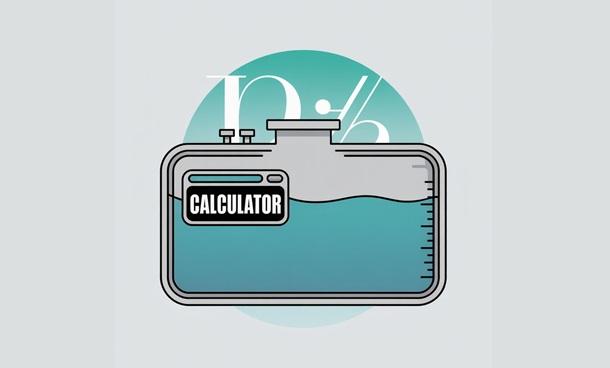Septic Tank Size Calculator
Estimate septic tank capacity by dimensions and bedroom guidelines — fast and clear
Tank by Dimensions (optional)
Bedrooms & Usage
Recommended Tank Size
By Dimensions
Bedroom Minimum
24‑hr Retention

Septic Tank Size Calculator: Step‑by‑Step Guide
Sizing a septic tank correctly is crucial for performance, longevity, and code compliance. This guide explains how to use the Septic Tank Size Calculator, the math behind it, and what factors (bedrooms, garbage disposal, retention time) mean for your final recommendation.
What this calculator estimates
- Tank volume by dimensions (length × width × liquid depth)
- Minimum septic tank sizing by bedrooms count (typical code guidelines)
- 24 hour retention septic check (occupants × gallons per day)
- garbage disposal septic size adjustment (+50% when applicable)
- Final recommended size rounded to a standard capacity
The core septic tank gallons formula
Volume by dimensions (gallons)
- Tank (gal) = Length (ft) × Width (ft) × Liquid Depth (ft) × 7.5
- 7.5 = gallons per cubic foot
- Using meters? The tool converts to feet automatically.
Bedroom minimums (typical residential guideline)
- 1–3 bedrooms → 1,000 gal
- 4 bedrooms → 1,200 gal
- 5 bedrooms → 1,500 gal
- 6 bedrooms → 1,750 gal
Retention check (optional)
- Retention minimum = Occupants × Daily use per person (gpd)
- Typical: 60–75 gpd/person (70 gpd default)
Garbage disposal adjustment
- If used, increase recommended size by 50%
Final recommendation rule
- Base recommendation = max(Bedroom minimum, Retention minimum)
- Adjust for disposal (+50% if applicable)
- Round up to the next standard size (e.g., 1,000, 1,200, 1,500, 1,750, 2,000 gal)
How to use the septic tank size calculator (step by step)
- Pick units
- Feet (ft) or meters (m). The septic tank size calculator converts as needed.
- Enter tank dimensions (optional)
- Length, width, and liquid depth (not overall tank height). This shows your current/desired shell volume in gallons.
- Select bedrooms
- Choose 1–6 based on the property. Most jurisdictions size by bedrooms.
- Set garbage disposal
- Select Yes if a disposal is (or will be) installed. This applies a +50% capacity adjustment.
- (Optional) Add occupants and gpd
- Enter expected occupants and daily use per person (60–75 gpd typical) to validate 24‑hour retention.
- Click Calculate
- You’ll see:
- Recommended tank size (rounded to a standard capacity)
- Volume by dimensions
- Bedroom minimum
- 24‑hr retention check
- Notes on disposal adjustment and rounding
Bedroom guideline table
| Bedrooms | Typical minimum tank size |
|---|---|
| 1–3 | 1,000 gal |
| 4 | 1,200 gal |
| 5 | 1,500 gal |
| 6 | 1,750 gal |
Worked examples
Example 1: 3 bedrooms, no disposal, 4 occupants
- Bedrooms → minimum = 1,000 gal
- Retention → 4 × 70 gpd = 280 gal
- Base recommendation = max(1,000, 280) = 1,000 gal
- Disposal? No → no adjustment
- Rounded standard size = 1,000 gal
- Result: Recommended 1,000‑gal tank
Example 2: 4 bedrooms, garbage disposal, 5 occupants @ 75 gpd
- Bedrooms → minimum = 1,200 gal
- Retention → 5 × 75 = 375 gal
- Base recommendation = max(1,200, 375) = 1,200 gal
- Disposal? Yes → 1,200 × 1.5 = 1,800 gal
- Rounded standard size = 2,000 gal (next standard above 1,800)
- Result: Recommended 2,000‑gal tank
Example 3: Dimensions check (optional)
- Tank shell: 9 ft × 6 ft × 4 ft liquid depth
- Volume by dimensions = 9 × 6 × 4 × 7.5 = 1,620 gal
- If code (bedrooms/retention) recommends 1,500 gal, you’re covered
- If code recommends 2,000 gal (e.g., disposal + bedrooms), increase capacity
Reading your results
- Recommended size: Rounded up to a standard capacity after applying bedroom/retention rules and disposal adjustment
- By dimensions: Actual/target shell volume for your tank geometry
- Bedroom minimum: What local rules commonly require based on bedroom count
- 24‑hr retention: Ensures your tank can retain a day’s wastewater for settling/clarification
Important considerations
- Liquid depth vs. total height: Use liquid depth for volume (exclude freeboard).
- Garbage disposal: Adds solids; many jurisdictions require +50% tank size.
- Pumping/cleaning interval: Larger tanks may allow longer intervals, but follow local guidance.
- Local code first: Requirements vary (soil, perk rates, high water tables, additives). Always confirm with your health department or building authority.
- Professional design: Complex sites or usage patterns (guest houses, multi‑family, high‑use kitchens) need an engineer or licensed septic designer.
Pro tips
- If your dimension volume is below the recommended size, upgrade the design; do not undersize.
- For close calls, round up—future occupancy or usage spikes can overwhelm small tanks.
- Pair tank sizing with proper drainfield design; both capacity and soil loading rate matter.
- Document your assumptions (bedrooms, occupants, gpd) for permitting.
FAQ/ Frequently Asked Questions
How do I calculate septic tank volume from dimensions?
Why does the formula use 7.5?
Do I use liquid depth or total tank height?
What are the typical minimum sizes by bedroom count?
- 1–3 bedrooms → 1,000 gal
- 4 bedrooms → 1,200 gal
- 5 bedrooms → 1,500 gal
- 6 bedrooms → 1,750 gal
How does a garbage disposal affect required tank size?
What is the 24‑hour retention check and why does it matter?
How does the calculator choose the recommended size?
Which standard sizes do you round to?
Can I enter dimensions in meters?
Does a larger tank mean less frequent pumping?
Are these numbers universal?
Do I need to size the drainfield separately?
When should I consult a professional?
You can explore Similar Calculator like this Dining Room Table Size Calculator 2025.

